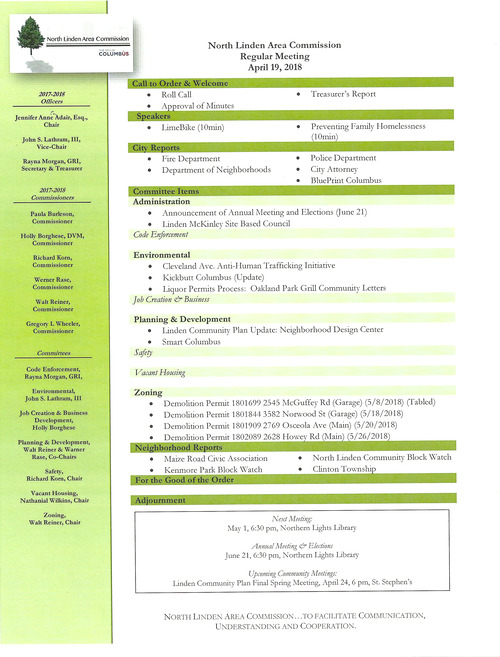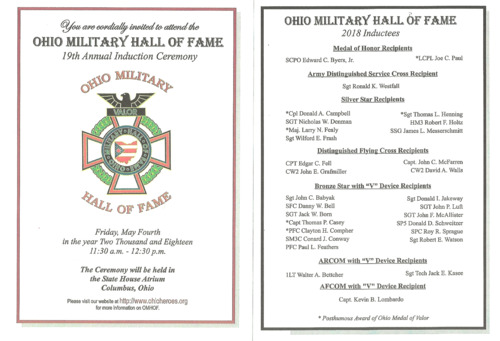North Linden Area Commission Regular Meeting April 19, 2018
- Preventing Family Homelessness
- LimeBike
- Anti-fracking presentation
- Department of Neighborhoods
- Planning and development
- Elections
- Cleveland Avenue Anti-Human Trafficking Initative
- Kickbutt Columbus
- Liquor permitting process
- Zoning variances
- Neighborhood reports
- Handouts
(This writeup was published in June 2018, well after the meeting's date.)
Preventing Family Homelessness
I don't have notes from this section of the meeting, but I do have a scan of the handout (PDF, 45 MB).
Highlights of the handout:
- Family homelessness and homelessness in general are up
- Shelters are "performing as designed"
- Columbus lacks a "coordinated homelessness prevention system"
- Some interesting PowerPoint designs courtesy the Prevent Family Homelessness Collaborative
- 43211 will be a pilot area for Columbus' integrated homelessness prevention system.
- Homelessness hot spots are Morse/161, Northeast, South Linden, Hilltop/Franklinton, King-Lincoln/Bronzeville, Near South Side, and Southeast.
LimeBike
Mike Reese introduced himself as an employee of Ice Miller, representing LimeBike. He says he worked with Mayor Coleman for 15 years.
LimeBike is a dockless bike rental program looking to start service in parts of Clintonville, parts of North and South Linden, and parts of South Side. He brought an "eleventh generation" bicycle to the meeting to demonstrate its functionality. They're working on an e-bike model as well.
The bike will cost $1 to unlock for first 30 minutes, $1 for each 30 min thereafter. No surge pricing, and monthly and membership pricing will be available. He says there are ways to get codes that can be used to unlock the bike without using a smartphone, but that functionality has not yet been deployed.
LimeBike has agreements with cities with exit clauses that the cities can trigger. No outside funding required from the city.
Commonly they'll have a local team that picks up oddly-placed bikes and move them back to areas that are permissable.
If a person tries to move a bike that's locked, the bike is programmed to play audio claiming that the bike will call the police, but Mike Reese says the bike does not actually call the police. The bike does contact LimeBike if it's moving without the pedals turning.
The "Linden Tier 2" is Joyce Avenue on east side, Weber on the north side, Jefferson and Hamilton on the west, south to 13th Avenue, but they're open to redefining the boundary.
The North Linden Area Commission chair, Jennifer Adair, asks a question about where people can and can't park bikes.
Mike Reese: there may be areas that the city wants people to park at or not park, the phone app will tell tell you if you're parking at a place that's not good or if there's a better place to park nearby. This is part of "a learning process" that is part of the 6-month trial period. If a bike isn't used for a day or two, the LimeBike crew will follow up with the bike, and the last known rider is stored by LimeBike so if someone puts a bike in a garage, they can respond. Says that 0.05%-0.02% of bikes are stolen, says that LimeBike is below the average.
Question from citizen: Why dockless? Why Linden instead of OSU? You're coming to a community where there are a lot of kids over the summer, there'll be a lot of people who aren't educated about bike sharing, why here? Why Linden when there isn't really lots of places to ride bikes? How do those impact your decisions?
Response: OSU has Zagster already; LimeBike is talking to OSU separately from Columbus. All these 3 pilot locaitons were chosen in a back-and-forth with the city; the city gave 8-10 neighborhoods that included not-dense, suburban areas. The city encouraged LimeBike to come here because of the Smart City initiative and the CBUS BRT, to complement that. Mike Reese understands that there aren't a lot of gorcery stores here, so LimeBike is open to extending the boundaries covered by LimeBike services, but LimeBike's boundaries are ultimately limited to the Columbus city limits. As to education or crime, LimeBike is committed to being here and doing education, and hiring locals.
Question: Maybe the city isn't letting you go this far north, but will you go up to Morse Road? Jobs and groceries are up there.
Mike Reese: No, we're not going to go that far north, and we have to stay within the City. (Portions of Morse Road, Westerville Road, and Cleveland Avenue are outside city limits.)
Commission chair Jennifer Adair says that there's not a lot here in North Linden here to ride to; that North Linden isn't really a community that goes to ride around for fun.
Response: We might expand or constrict the boundaries based on what we learn. We're confined based on the city public service departments.
Question from citizen: We have a number of people who might rid if it got to them someplace useful. Would you do any education in the schools in the area regarding these bikes?
Mike Reese: Yes to education in schools, and we'll have a helmet giveaway program.
Commission vice-chair John Lathram III: I'm the Smart Columbus liason to North Linden; one of the issues that we had wtih Car2go is it withdrew.
Jennifer Adair: Will you be askign for a recommendation from the [North Linden area] commission?
Mike Reese: A lot of this is a work in process, and we'll go back to the city to advocate for going as far north as Northern Lights and out to Silver Drive. Can you send me an email that I can present to the city and use to address your questions? I can come back if you want, and come back to share with you the final boundaries.
Question from Walt Reiner (zoning chair, planning and development co-chair): Who's funding this?
Mike Reese: This is a for-profit; this costs nothing to taxpayers because docks costs money and this doesn't have docks. It's invested in by investors.
LimeBike handout
The following slide deck was distributed by LimeBike representatives at the meeting.
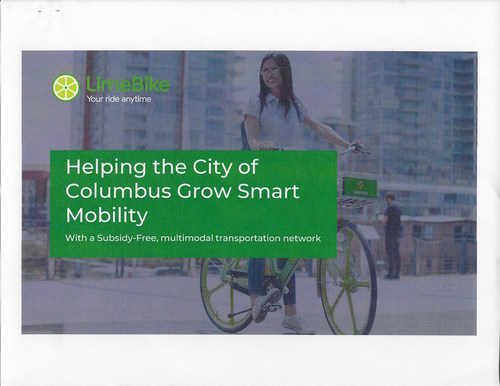
Helping the City of Columbus grow smart mobility with a subsidy-free, multimodal transportation network.
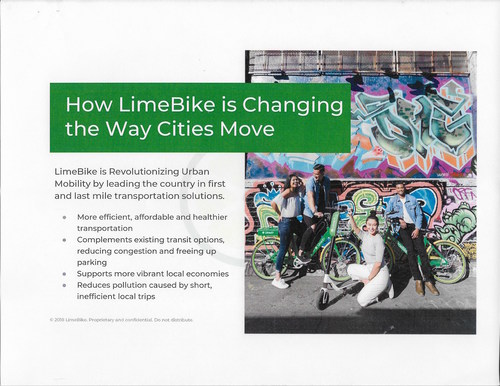
How LimeBike is changing the way cities move
LimeBike is revolutionizing urban mobility by leading the country in first and last mile transportation solutions.
- More efficient, affordable and healthier transportation
- Complements existing transit options, reducing congestion and freeing up parking
- Supports more vibrant local economies
- Reduces pollution caused by short, inefficient local trips
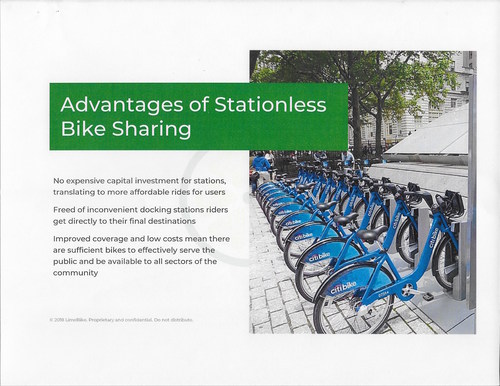
Advantages of stationless bike sharing
No expensive capital investment for stations, translating to more affordable rides for users.
Freed of inconvenient docking statinos, riders get directly to their final destinations.
Improved coverage and low costs mean there are sufficient bikes to effectively serve the public and be available to all sectors of the community.
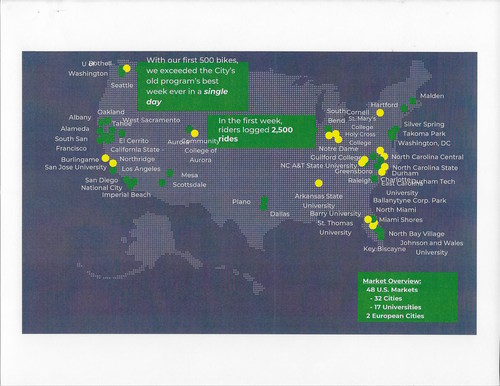
A map of the areas where LimeBike is active in the United States, with significant text conflicts. There are a number of green and yellow dots on the map, the difference between them is not noted. A text box with an arrow pointing to Seattle reads: "With our first 500 bikes, we exceeded the City's old program's best week ever in a single day". A text box pointing towards mid-Indiana reads: "In the first week, Riders logged 2,500 rides". A box in off the southeast coast of the United States provides a market overview: 48 U.S. markets including 32 cities and 17 universities, 2 European cities. The data is not dated.
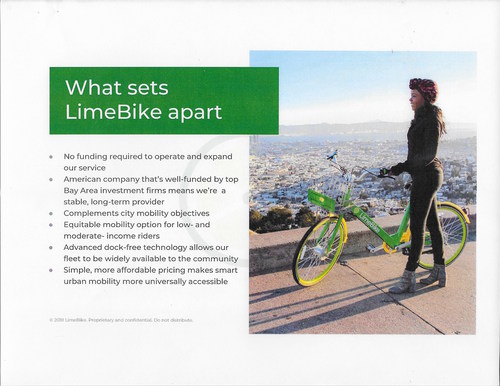
What sets LimeBike apart
- No funding required to operate and expand our service
- American company that's well-funded by top Bay area investment firms means we're a stable, long-term provider
- Complements city mobility objectives
- Equitable mobility option for low- and moderate-income riders
- Advanced dock-free technology allows our fleet to be widely available to the community
- Simple, more affordable pricing makes smart urban mobility more universally accessible
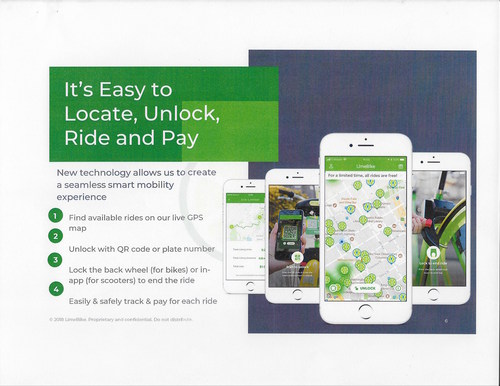
It's easy to locate, unlock, ride and pay
New technology allows us to create a seamless smart mobility experience
- Find available rides on our live GPS map
- Unlock with QR code or plate number
- Lock the back wheel (for bikes) or in-app (for scooters) to end the ride
- Easily & safely track & pay for each ride
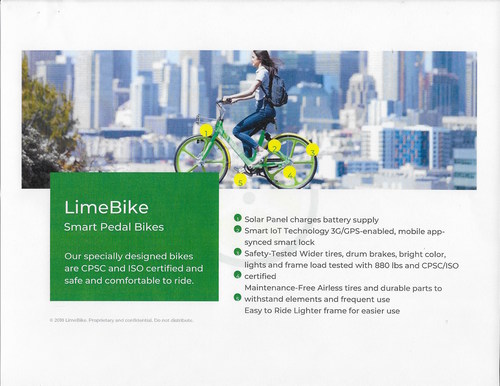
LimeBike Smart Pedal Bikes
Our specially designed bikes are CPSC and ISO certified and safe and comfortable to ride
- Solar panel charges battery supply
- Smart IoT Technology 3G/GPS-enabled, mobile app-synced smart lock
- Safety-Tested Wider tires, drum brakes, bright color, lights and frame load tested with 880 lbs and CPSC/ISO certified
- Maintenance-Free Airless tires and furable parts to withstand elements and frequent use
- Easy to Ride Lighter frame for easier use
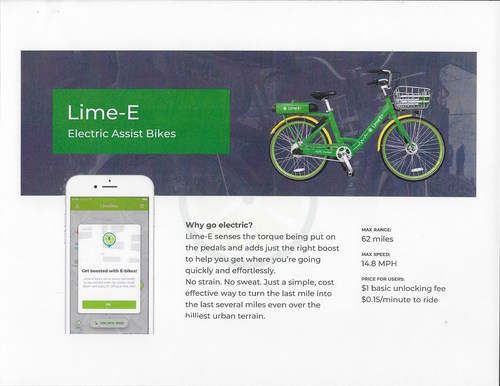
Lime-E Electric Assist Bikes
Why go electric? Lime-E senses the torque being put on the pedals and adds just the right boost to help you get where you're going quickly and wffortlessly.
No strain. No sweat. Just a simple, cost effective way to turn the last mile into the last several miles even over the hilliest urban terrain.
Max range: 62 miles. Max speed: 14.8 mph. Price for users: $1 basic unlocking gee, $0.15/minute to ride.
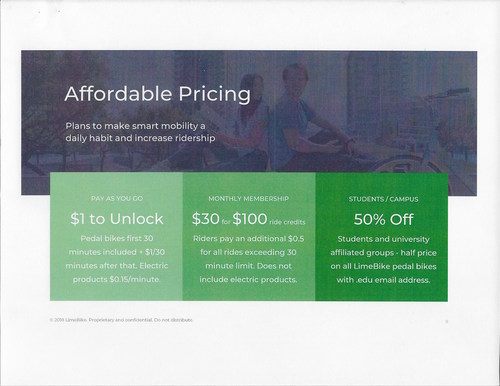
Affordable Pricing
Plans to make smart mobility a daily habit and increase ridership.
Pay as you go: $1 to unlock. Bedal bikes first 30 minutes included + $1/30 minutes after that. Electric products $0.15/minute.
Monthly Membership: $30 for $100 ride credits. Riders pay an additional $0.50 for all rides exceeding 30 minute limit. Does not include electric products.
Students/Campus: 50% off. Students and unifrsity affiliated groups — half price on all LimeBike pedal bikes with .edu email address.

Managing dock free operations: on-the-ground team led by a local general manager
Operations: Our operations team actively manages our smart mobility fleet, rebalancing bikes and scooters and responding to any support calls.
Customer service: We maintain 24 hour customer service and respond to urgent issues within 2 hours during regular business hours.
Fleet management: Our team will rebalance under-utilized bikes and scooters to meet higher demand and ensure equitable service distribution.
Maintenance: We cover all maintenance and routine checks of equipment.
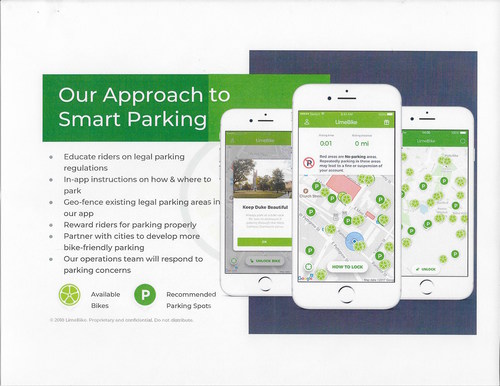
This slide would seem to exist to address concerns about people leaving bikes wherever. The slide shows a series of mobile phone mock-ups for LimeBike app maps of available bikes and recommended parking areas. One screenshot shows a popup: "Red areas are no-parking areas. Repeatedly parking in these areas may lead to a fine or suspension of your account."
Our approach to smart parking
- Educate riders on legal parking regulations
- In-app instructions on how & where to park
- Geo-fence existing legal parking areas in our app
- Reward riders for parking properly
- Parner with cities to develop more bike-friendly parking
- Our operations team will respond to parking concerns.
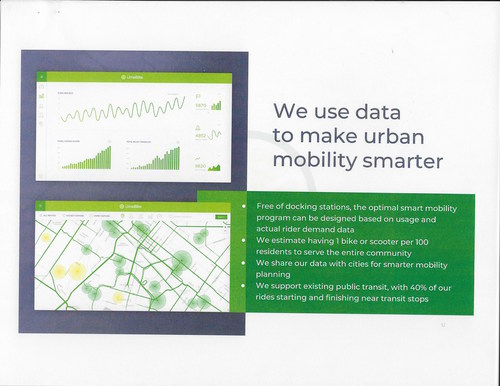
We use data to make urban mobility smarter
- Free of docking stations, the optimal smart mobility program can be designed based on usage and actual rider demand data
- We estimate having 1 bike or scooter per 100 residents to serve the entire community
- We share our data with cities for smarter mobility planning
- We support existing public transit, with 40% of our rides starting and finishing near public transit stops
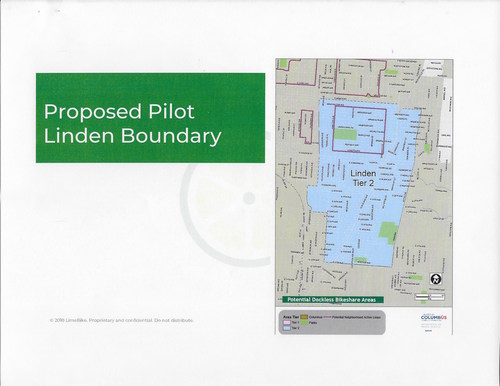
This slide, titled "Proposed pilot Linden boundary", features a blue area labeled "Linden Tier 2" on a map of Columbus titled "Potential Dockless Bikeshare Areas".
The borders of the area are as follows:
South side: East 13th Avenue
East: Joyce Avenue
North, from east to west: Denune Avenue, Westerville Road to Cleveland Avenue, Cleveland avenue north from Westerville Road to Weber Road.
West: From Weber Road, south on McGuffey Road to Duxberry Avenue, west on Duxberry to Grasmere Avenue to East 22nd Avenue, East on East 22nd Ave. to Hamilton Avenue, south on Hamilton Avenue to East 13th Avenue.
The map also highlights some of the "Neighborhood Active Loop" walking paths.
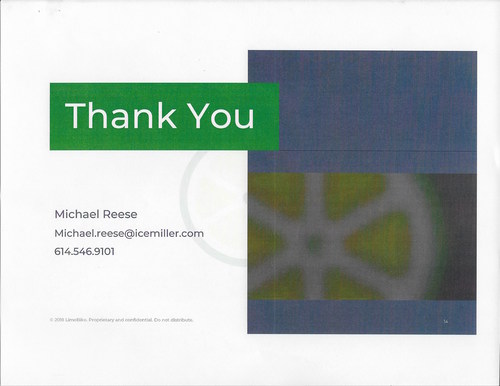
The final slide in the deck, providing Michael Reese's contact information: michael.reese@icemiller.com (614) 546-9101.
Anti-fracking presentation
A representative of the Columbust Community Bill of Rights campaign presents on their work. It's a campaign to reduce frack waste water disposal into injection wells. The presenter talks about toxic, radioactive waste being dumped into the watershed through injection wells. Prior to 2004, she says, Columbus had the rights to control the gas and oil industry and Ohio took that right away and gave it to the Ohio Department of Natural Resources.
The campaign is collecting signatures during next 2.5 months to get an issue on the ballot, and collecting donations to give out anti-frack-waste signs. Their website is columbus bill of rights dot org, and here's their handout:
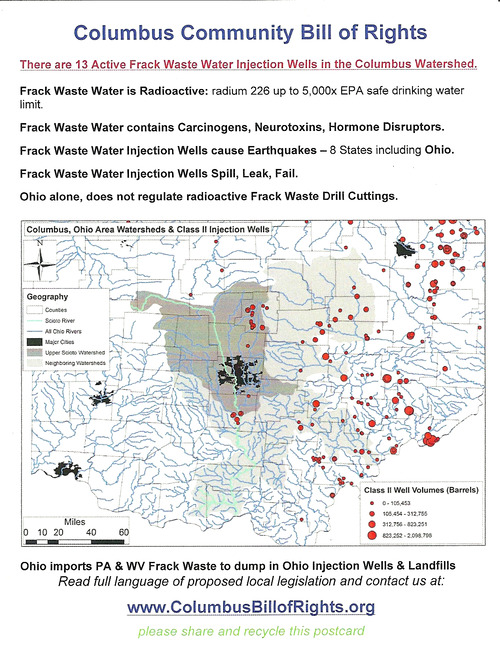
One side of a flier from the Columbus Community Bill of Rights speaker.
Columbus Community Bill of Rights
There are 13 Active Frack Waste Water Injection Wells in the Columbus Watershed.
Frack Waste Water is Radioactive: radium 226 up to 5,000x EPA safe drinking water limit.
Frack Waste Water contains Carcinogens, Neurotoxins, Hormone Disruptors.
Frack Waste Water Injection Wells cause Earthquakes — 8 States including Ohio.
Frack Waste Water Injection Wells Spill, Leak, Fail.
Ohio alone, does not regulate radioactive Frack Waste Drill Cuttings.
(a map of the Columbus, Ohio area watersheds and Class II injection wells, showing major cities, the Upper Scioto watershed, neighboring watersheds, the Scioto river, all streams and rivers in Ohio, and all Class II wells by well volume in barrels.)
Ohio imports PA & WV Frack Waste to dump in Ohio Injection Wells & Landfills
Read full language of proposed local legislation and contact us at: www.ColumbusBillofRights.org
please share and recycle this postcard
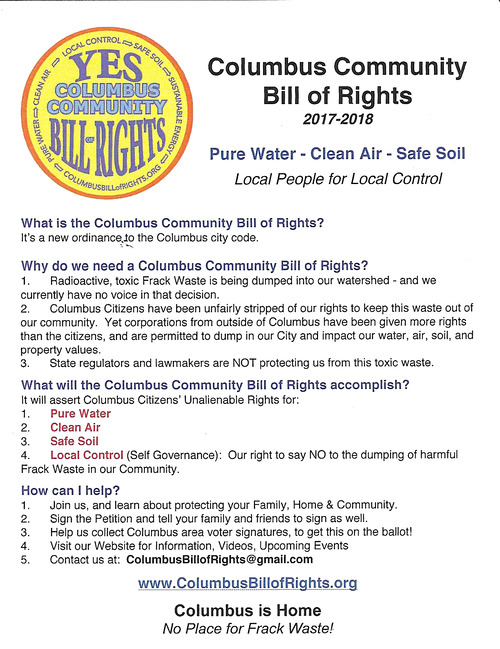
The other side of their flier.
Columbus Community Bill of Rights, 2017-2018
Pure Water - Clean Air - Safe Soil
Local People for Local ControlWhat is the Columbus Community Bill of Rights?
It's a new ordinance to the Columbus city code.Why do we need a Columbus Community Bill of Rights?
- Radioactive, toxic Frack Waste is being dumped into our watershed - and we currently have no voice in that decision.
- Columbus Citizens have been unfairly stripped of our rights to keep this waste out of our community. Yet corporations from outside of Columbus have been given more rights than the citizens, and are permitted to dump in our City and impact our water, air, soil, and property values.
- State regulators and lawmakers are NOT protecting us from this toxic waste.
What will the Columbus Community Bill of Rights accomplish?
It will assert Columbus Citizens' Unalienable Rights for:
- Pure Water
- Clean Air
- Safe Soil
- Local Control (Self Governance): Our right to say NO to the dumping of harmful Frack Waste in our Community.
How can I help?
- Join us, and learn about protecting your Family, Home & Community.
- Sign the Petition and tell your family and friends to sign as well.
- Help us collect Columbus area voter signatures, to get this on the abllot!
- Visit our Website for Information, Videos, Upcoming Events
- Contact us at: ColumbusBillofRights@gmail.com
Department of Neighborhoods
Chris from the Columbus Department of Neighborhooods: On May 18 there will be housing and eviction notices training at the Columbus Metropolitan Library Shepard branch, at 850 North Nelson road.
A minor discussion of the budget allocations for North Linden occurs, mentioning including $15 million in North Linden projects by 2023 and lot of money ($39 million) for street resurfacing. The 2018 Capital Improvement Budget and those of previous years can be found on Columbus.gov, along with the 2018-2023 Capital Improvement Program.
Planning and development
Linden Community Plan
Planning event will be held on April 24 from 6 to 8 p.m. at St. Stephens' Community House (1500 East 17th Avenue) with free food, focused on ten ideas to save Linden. A pamphlet was passed around at the area commission meeting:
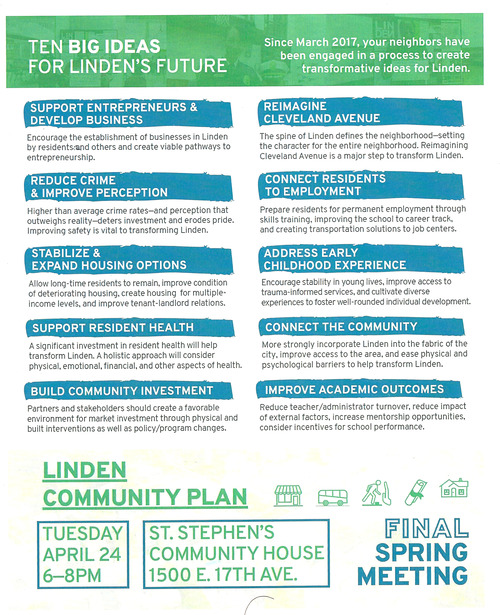
Ten Big Ideas for Linden's Future
- Support entrepreneurs and develop business: Encourage the establishment of businesses in Linden by residents and other and create viable pathways to entrepreneurship.
- Reduce crime and improve perception: Higher than average crime rates — and perception that outweighs reality — deters investment and erodes pride. Improving safety is vital to transforming Linden.
- Stabilize and expand housing options: Allow long-time residents to remain, improve condition of deteriorating housing, create housing for multiple income levels, and improve tenant-landlord relations.
- Support resident health: A significant investment inresident health will help transofrm Linden. A hoslistic approach will consider physical, emotional, financial, and other aspects of health.
- Build community investment: Partners and stakeholders should create a favorable environment for market investment through physical and built interventions as well as policy/program changes.
- Reimagine Cleveland Avenue: The spine of Linden defines the neighborhood — setting the character for the entire neighborhood. Reimagining Cleveland Avenue is a major step to transform Linden.
- Connect Residents to employment: Prepare residents for permanent employment through skills training, improving the school to career track, and creating transportation solutions to job centers.
- Address early childhood experience: Encourage stability in young lives, improve access to trauma-informed services, and cultivate diverse experiences to foster well-rounded individual development.
- Connect the community: More strongly incorporate Linden into the fabric of the city, improve access to the area, and ease physical and psychological barriers to help transform Linden.
- Improve academic outcomes: Reduce teacher/administrator turnover, reduce impact of external factors, increase mentorship opportunities, consider incentives for school performance.
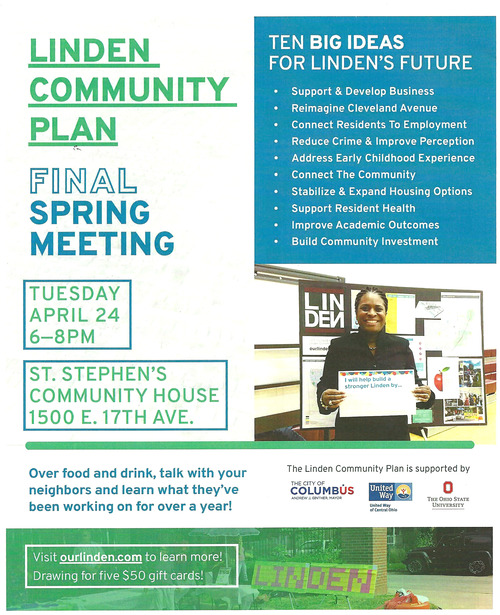
Elections
Area commission lections will be held on June 21, 2018 at the Northern Lights Library (4093 Cleveland Avenue). Individuals seeking to run have until June 7 to file to be listed on the ballot. Candidates must collect the signatures of 25 residents of North Linden, and must be a resident or business owner within the North Linden area boundaries.
There may have been a handout for this; I didn't snag it.
Cleveland Avenue Anti-Human Trafficking Initative
Now expanding across the city.
Kickbutt Columbus
They picked up a bunch of trash, set unspecified records for participation and trash pick-up. Someone got out of his car and helped on the spot. More needles were found this year compared to last year.
Commissioner Paula Burleson says that there'll be a litter survey process leading to allocation of trash picck-up teams.
Liquor permitting process
It's opening up again; there's going to be hearings open to the public. Meetings of the Ohio Liquor Control Commission are listed on their website.
One of the establishments that has been on the area commission's "list" is Oakland Park Grill. The Grill's neighbors have been engaged on the topic of its problems. The area commission can comment on any business that holds a liquor permit. (Oakland Park Grill is notorious because of gunfire and murders in the last year, including the most recent one in 2018).
Comment from someone whose name I caught as 'Beth': In order to object to a liquor permit, the area commission needs letters from the citizens in the area. In order to get the permit renewal blocked, the city needs to have reason to object to the liquor permit. Overwhelming community complaints is what's necessary.
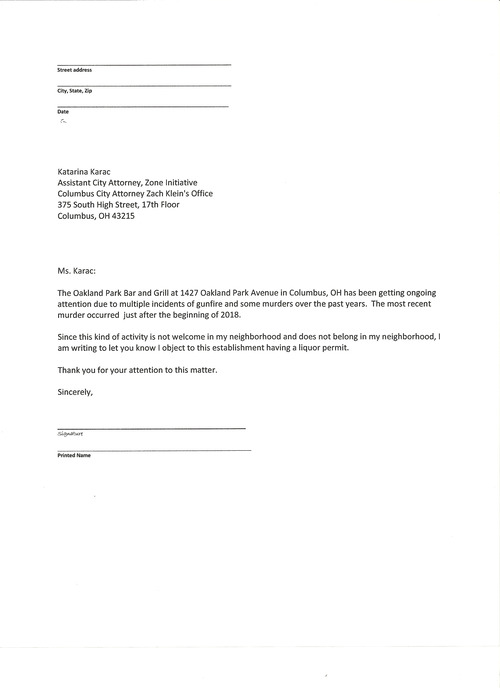
A form letter handed out that opposes the renewal of the Oakland Park Bar and Grill's liquor license.
Katarina Karac
Assistant City Attorney, Zone Initiative
Columbus City Attorney Zach Klein's Office
375 South High Street, 17th Floor
Columbus, OH 43215Ms. Karac:
The Oakland Park Bar and Grill at 1427 Oakland Park Avenue in Columbus, OH has been getting ongoing attention due to multiple incidents of gunfire and some murders over the past few years. The most recent murder occurred just after the beginning of 2018.
Since this king of activity is not welcome in my neighborhood and does not belong in my neighborhood, I am writing to let you know I object to this establishment having a liquor permit.
Thank you for your attention to this matter.
Sincerely, (signature, printed name)
Zoning variances
1801699, 2545 McGuffey Road
Application by Habitat for Humanity to demolish. Approved.
1801844, 3582 Norwood Street
Resident applied; garage has holes in roof.
Commissioner Richard Korn asks how it got to that state; commission chair Jennifer Adair doesn't know.
Approved.
1801909, 2769 Osceola
Property owned by the land bank.
Holly Borghese, commissioner, says she drove by it and there was a sign saying "please, for the love of god, tear this down."
Approved.

1802809, 2628 Howey
Acquired by Land Bank on Feb 13; Commissioner Holly Borghese says it has a hole in the roof.
Audience member Nate says that he's tired of the houses being demolished before they go up for sale.
Jennifer says that the Land Bank lumps demolition approvals because they have to get a bid out for contractors, but just because the land bank has it doesn't mean that it's going to be torn down tomorrow.
Nate wants the homes for elderly and handicapped; John Lathram III says that these homes aren't near public transit services needed by elderly and handicapped.
Commissioner Walt Reiner starts discussion, says that the city should start doing preventative maintenance rather than letting them go into disrepair. Should have early interventions rather than spending $6k, $7k a pop to demolish them.
Approved, but Walt abstains.
Neighborhood reports
John Lathram III says that the community watch has new priorities for the year: increase number of ppl coming to meetings.
John Lathram III says that litter cleanup in US costs significant amounts of monet (I didn't get the number), adds that community will do litter pickup.
Letter from councilmember Mitchell Brown: Fire Station 16 will be built anew; there's $7 million in the 2018 capital improvements budget for construction; timeline not yet set but the money is appropriated.
The Columbus Land Bank has a Facebook page now.
Handouts
Smart Columbus was not discussed at this meeting, but there was a Smart Columbus handout available on the table.
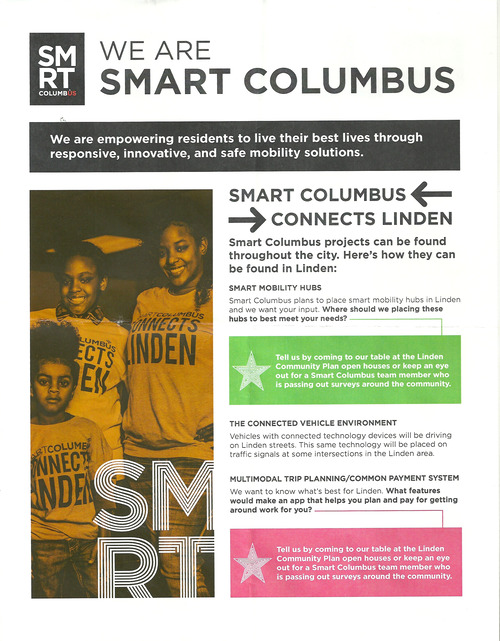
Smart Columbus Connects Linden: Smart Columbus projects can be found throughout the city. Here's how they can be found in Linden:
- Smart Mobility Hubs: Smart Columbus plans to place smart mobility hubs in Linden and we want your input. Where should we placing these hubs to best meet your needs? Tell us by coming to our table at the Linden Community Plan open houses or keep an eye out for a Smart Columbus team member who is passing out surveys around the community.
- The Connected Vehicle Environment: Vehicles with connected technology devices will be driving on Linden streets. This same technology will be placed on traffic signals at some intersections in the Linden area.
- Multimodal Trip Planning/Common Payment System: We want to know what's best for Linden. What features would make an app that helps you plan and pay for getting around work for you? Tell us by coming to our table at the Linden Community Plan open houses or keep an eye out for a Smart Columbus team member who is passing out surveys around the community.
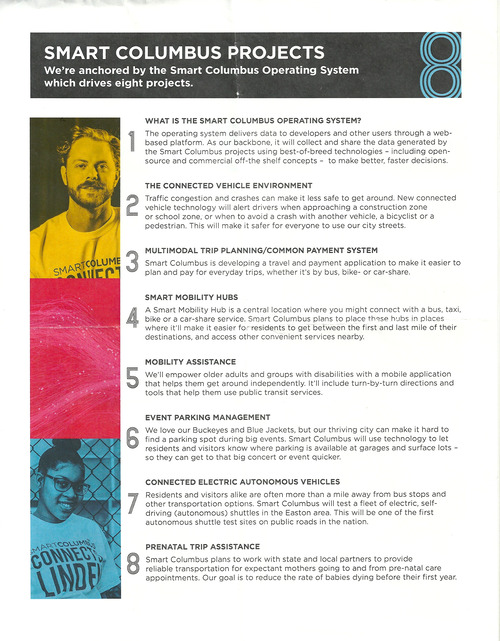
Smart Columbus Projects: We're anchored by the Smart Columbus Operating System which drives eight projects.
- What is the Smart Columbus Operating System? The operating system delivers data to developers and other users through a web-based platform. As our backbone, it will collect and share the data generated by the Smart Columbus projects using best-of-breed technologies — including open-source and commercial off-the-shelf concepts — to make better, faster decisions.
- The Connected Vehicle Environment: Traffic congestion and crashes can make it less safe to get around. New connected vehicle technology will alert drivers when approaching a construction zone or shool zone, or when to avoid a crash with another vehicle, a bicyclist or a pedestrian. This will make it safer for everyone to use our city streets.
- Multimodal Trip Planning/Common Payment System: Smart Columbus is developing a travel and payment application to make it easier to plan and pay for everyday trips, whether it's by bus, bike- or car-share.
- Smart Mobility Hubs: A Smart Mobility Hub is a central location where you might connect with a bust, taxi, bike or car-share service. Smart Columbus plans to place these hubs in places where it'll make it easier for residents to get between the first and last mile of their destinations, and access other convenient services nearby.
- Mobility Assistance: We'll empower older adults and groups with disabilities with a mobile application that helps them get around independently. It'll include turn-by-turn directions and tools that help them use public transit services.
- Event Parking Management: We love our Buckeyes and blue Jackets, but our thriving city can make it hard to find a parking sport during big events. Smart Columbus will use technology to let residents and visitors know where parking is available at garages and surface lots — so they can get to that big concert or event quicker.
- Connected Electric Autonomous Vehicles: Residents and visitors alike are often more than a mile away from bus stops and other transportation options. Smart Columbus will test a fleet of electric, self-driving (autonomous) shuttles in the Easton area. This will be one of the first authonomous shuttle test sites on public roads in the nation.
- Prenatal Trip Assistance: Smart Columbus plans to work with state and local partners to provide reliable transportation for expectant mothers going to and from pre-natal care appointments. Our goal is to reduce the rate of babies dying before their first year.
